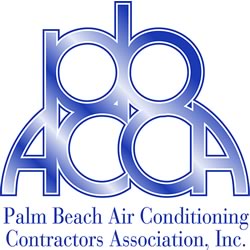This will lessen the mystery.
When purchasing an air conditioner, consumers are often overwhelmed by the array of efficiency ratings, abbreviation and acronyms used to describe or explain the products. Read on to help lessen the mystery of purchasing a home comfort system.
General Terms:
HVACR – Heating, Ventilating, Air Conditioning and Refrigeration refers to the indoor comfort industry.
HVACR Contractors – companies which design, install, maintain, and service HVACR systems.
ACCA – Air Conditioning Contractors of America is a national trade association which represents heating, ventilation, air conditioning and refrigeration contractors. Their history as an organization traces back to 1914. ACCA has over 4,000 members and 64 local chapter organizations.
PBACCA –The Palm Beach Air Conditioning Contractors Association (PBACCA) is a non-profit trade association of service to heating, ventilation, air conditioning, and refrigeration (HVACR) contractors. PBACCA has been serving the local area for 40 years. Locally in the Palm Beach area the contractors are members of PBACCA. (PBACCA is not a chapter of ACCA. PBACCA is an independent trade association.)
ARI – Air-Conditioning and refrigeration Institute is a nonprofit, voluntary organization comprised of heating, air conditioning and refrigeration manufactures. ARI publishes standards for testing and rating heat pumps and air conditioners to provide you with a standardized measure of comparison. So, ARI ensures a level of quality within the industry.
DOE – The Department of Energy is a federal agency in charge of setting industry efficiency – standards and monitoring the consumption of energy sources.
Watt (W) – a Watt is a unit of electricity.
Kilowatt (kW) – a kilowatt equals 1,000 Watts. A kilowatt hour (kWh) is the amount of kilowatts of electricity used in one hour of operation of any equipment.
BTU – British Thermal Unit is the amount of heat that will raise or lower one pound of water by one degree Fahrenheit. A Btuh is how many Btu’s are used per hour.
Ton – Air conditioners are generally sized in tons. Typical sizes for single family residences and between two and five tons. Each ton equals 12,000 Btuh. It is important to note that actual capacity is not constant and will change based on outdoor or indoor temperatures. The published capacity rating of air conditioners is based on performance at the ARI standard temperature levels of 95F outside, 80 F inside.
Efficiency – A rating on comfort equipment is similar to the miles per gallon rating on your car. The higher the rating number, the more efficient the system and the lower your fuel (electricity) consumption will be. You can save a lot of money with a high efficiency unit. Depending on your local climate, lifestyle and electricity rates, savings will vary. Florida residents know “It’s not the heat, it’s the humidity” when determining comfort levels. It’s important to note that humidity is a major factor in comfort. The higher humidity, even at the same temperature, will feel hotter and “stickier”. Your air conditioning system removes humidity from the home only while it’s running. Higher efficiency systems will typically run longer cooling cycles, but at a reduced energy consumption, allowing more humidity to be removed from the home thereby creating a more comfortable environment without sacrificing the energy costs of a lower SEER system. If you have a system that efficiently removes humidity you may be able to set the thermostat at a higher temperature and save even more.
SEER – Seasonal Energy Efficiency Ratio is the amount of cooling your equipment delivers for every dollar spent on electricity. SEER applies to air conditioners and heat pumps. In the past, a unit with a SEER of 8.00 was considered standard efficiency. After January 1, 1992, the current minimum SEER required by the DOE is 10.00 and 15.00 or higher SEER is considered high efficiency. This requirement will increase to a minimum of 13 SEER starting January 1, 2006, which means consumers will no longer be able to purchase equipment below that rating.
HSPF – Heating seasonal performance factor is similar to SEER, but it measures the efficiency of the heating portion of your hear pump. Like SEER, industry minimums have been raised recently, and the minimum is now 6.80 HSPF.
Sound Ratings – Although sound does not affect the efficiency of a unit, it will certainly affect your comfort. If your unit has a low sound level, you will hardly notice it is operating. But if it has a higher sound level, it may mean you good night’s sleep is disturbed every time it runs. Many local jurisdictions have maximum sound levels in residential areas. Check with your contractor to be sure you’re following the law.
Decibel (db) – A decibel describes the relative loudness of a sound. Some common sound are fairly close to a typical air conditioner: human voice, 7.0 decibels; blender, 8.8 decibels.
Sound Rating Number (SRN) – Sound is measured in bells (a bell equals 10 decibels). The SRN of a unit is based on ARI test, performed at ARI standard rating conditions. Average sound rating range from 7.0 to 8.0 decibels. The lower the SRN rating, the quieter the unit.
Indoor Coils – A homes comfort system consists of two components: The outdoor unit (condenser or heat pump) and the indoor unit (coil or air handler). Combinations of various units will result in vastly different efficiency ratings.
The Price of Quality – There is more to buying a system than ratings. The quality and installation of equipment and materials used, as well as the reliability of the manufacturer and installing contractor can all affect your long-term satisfaction and comfort. Top quality, high efficiency equipment will cost more initially, but it will save you money on utility bills and service calls for years to come. Be sure to weigh all the factors before choosing your new system.
Reprint in part, from HVAC City.

